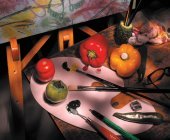|
ShutterThere are two basic designs of a camera shutter Copal or Leaf Focal Plane Copal: This type of design is mounted between lens elements. It contain a set of thin metal blades overlapping each other to block the light. When activated, they open from the center like a flower, for pre-set time and collapse back to shut and block the light again. This design is used in a range finder, EVIL, TLR and monorail cameras. At any speed and at any given time, this opening is always fully open. So at that precise moment, a flash can be fired. That is why there is no problem of flash synchronizing with copal shutter. However, there is limitation on fast speed. It requires very high mechanical and machining precision to achieve anything beyond 1/500th of a second. Though this design offers an advantage for synchronizing speed, the disadvantage is that we need separate mechanisms for each individual lens, and we have to pay for it! Focal plane: Most of SLR cameras have this mechanism. It is built in the camera body, near the film plane. There are two blinds or curtains. When we click, the first blind move out of the path of the light and allows the light to fall on the film to expose. After the pre-set time out, the second blind moves in and blocks the light. This mechanical movement either can be in vertical or horizontal direction.
Vertical direction will take 1/250th of a second for mechanical movements of blinds. This is the minimum time, for which lens opening is full. In case, when it is fully open, we can fire a flash, and that is the flash synchronizing speed of the camera. However, faster speeds beyond 1/250th of a second are achieved when first blind is not fully open and second blind starts following the first blind. That is how fast speeds like 1/500, 1/1000, 1/2000, 1/4000 or 1/8000th of a second are achieved. However, at faster speed, the frame is never completely open at any given time so we cannot use flash at those speeds. If we use a flash with these speeds, we will get just part if a photograph, and remaining part will come out black. In DSLR cameras with half frame size image sensor, this time limit is less up to 1/400th of a second. (because the opening is smaller so it takes lesser time.) Advantage of this design is, we can get faster speeds. Secondly, as this mechanism is fitted in the camera body, lens does not require the mechanism, so changing a lens is comparatively easier and cheaper than a copal.
Which ever is the mechanism, basic function is to expose the film for specified time. On a dial, we will find numbers like 1, 2, 4, 8, 15, 30, 60, 125, 250, 500, 1000, 2000 and so on. Number showed on the dial is actually a reverse figure, means 500 on the dial is 1/500th of a second. As we can notice, each next number is double in value. So time given for exposure is either double or half, when we move to next value. This has to compensate with aperture setting and when we change the speed, change the aperture as well. For example, if we are getting correct exposure at 1/60th of a second and f 8 aperture, and we shift to 1/125th of a second (one step), then compensate this less time with wider aperture, which is f 5.6 (one stop wider) to get the same brightness in exposure. Apart from numerical figures, there is "B" (bulb) or "T" (time) on the dial. "B" is for bulb or time exposure and till we keep the camera release button pressed, the shutter window will remain open. "T" also has the same function but "T" does not require the camera release button to be kept pressed, to keep the shutter open. It will remain open till you change or rotate the speed dial to any other value.
Effects of different speeds: Different speed gives different effect on exposure. Fast speed will freeze any movement of the subject. A waterfall will look stand still when shot at 1/2000th of a second but if it is shot at 1/2 second, the movement of falling water will be recorded as motion blur. Both these effects has its own artistic appeal and it is a personal choice. Faster the movement of the subject, faster the speed we will require to stop or freeze the movement. When the camera is on shutter priority mode, then we can manually select a speed and the camera will automatically set the required aperture. Apart from this mechanical design, there is an electronic version, which is used in high speed cameras.
Return back to Camera from shutter
Auto focus mechanism of camera
Other photographic accessories
|






